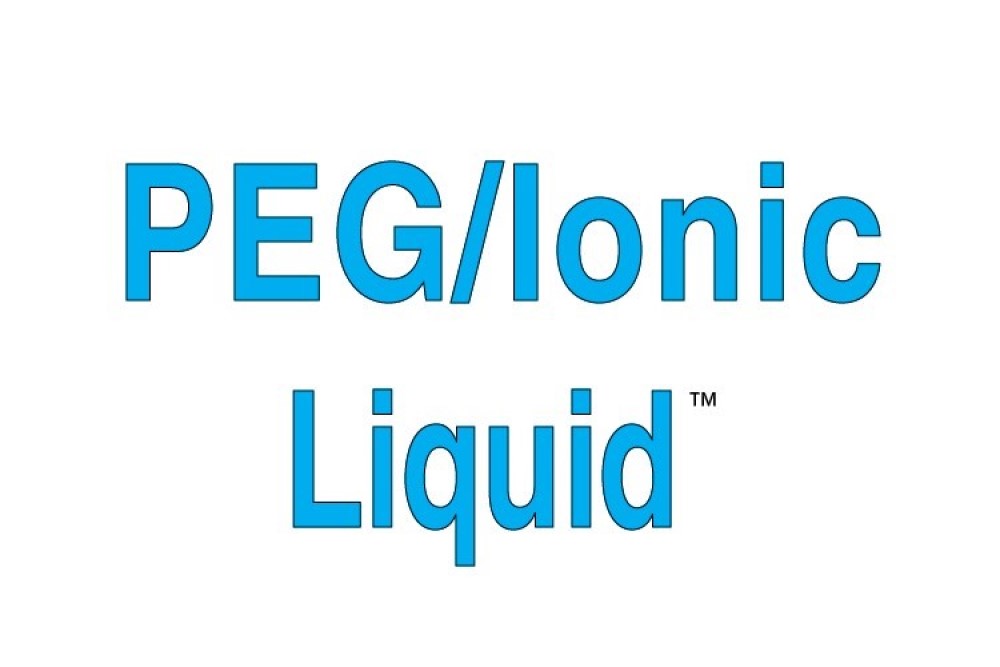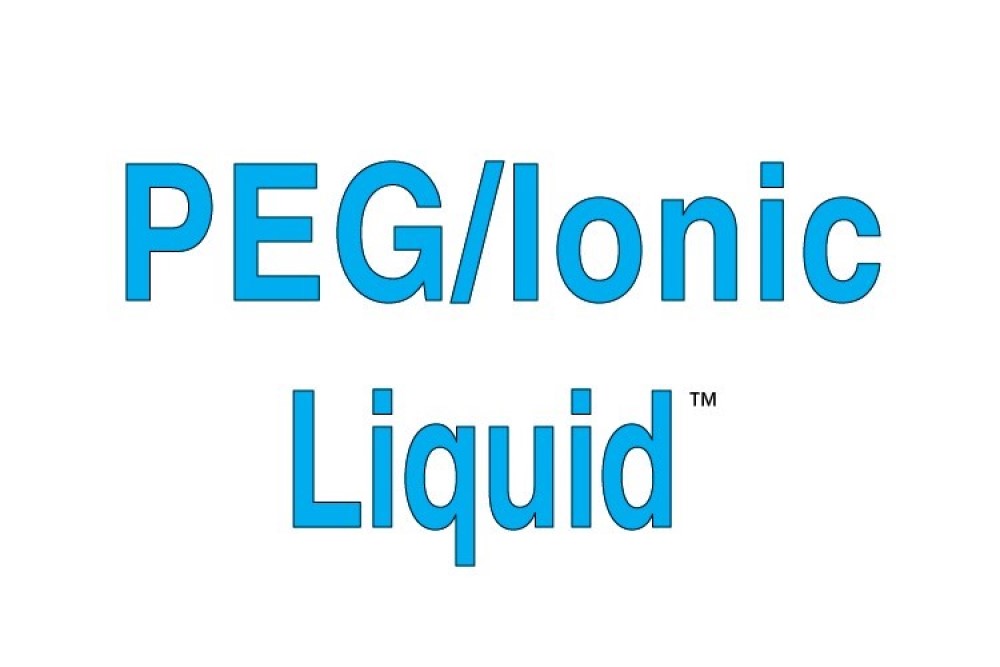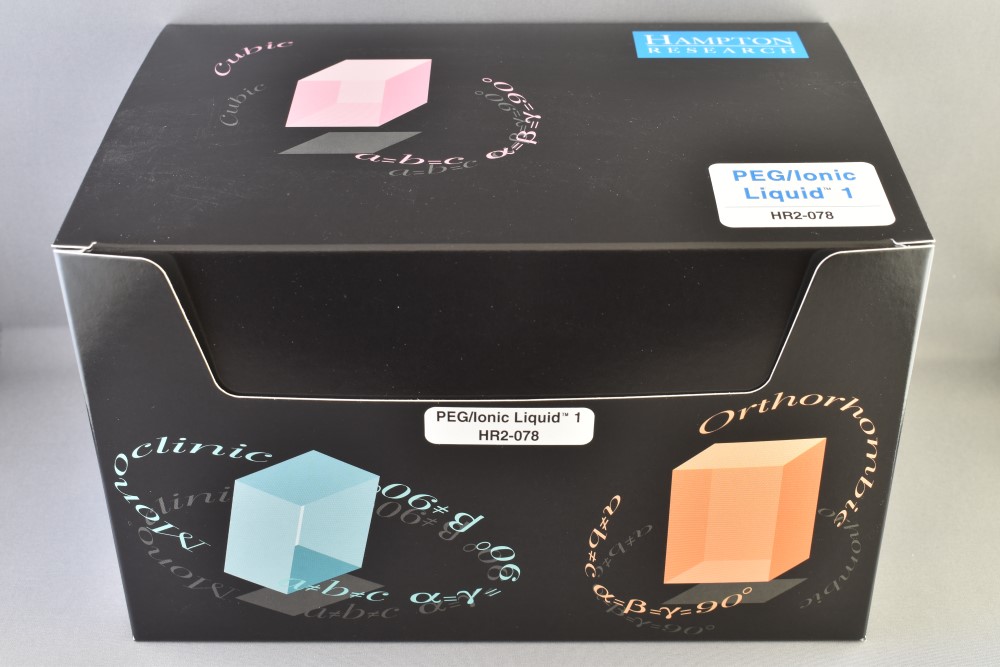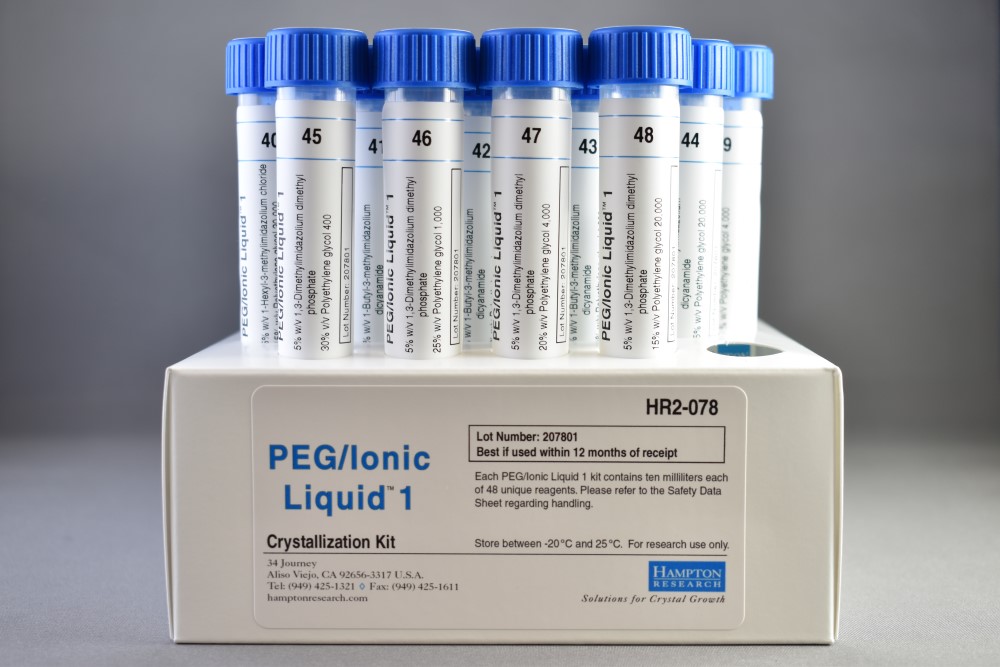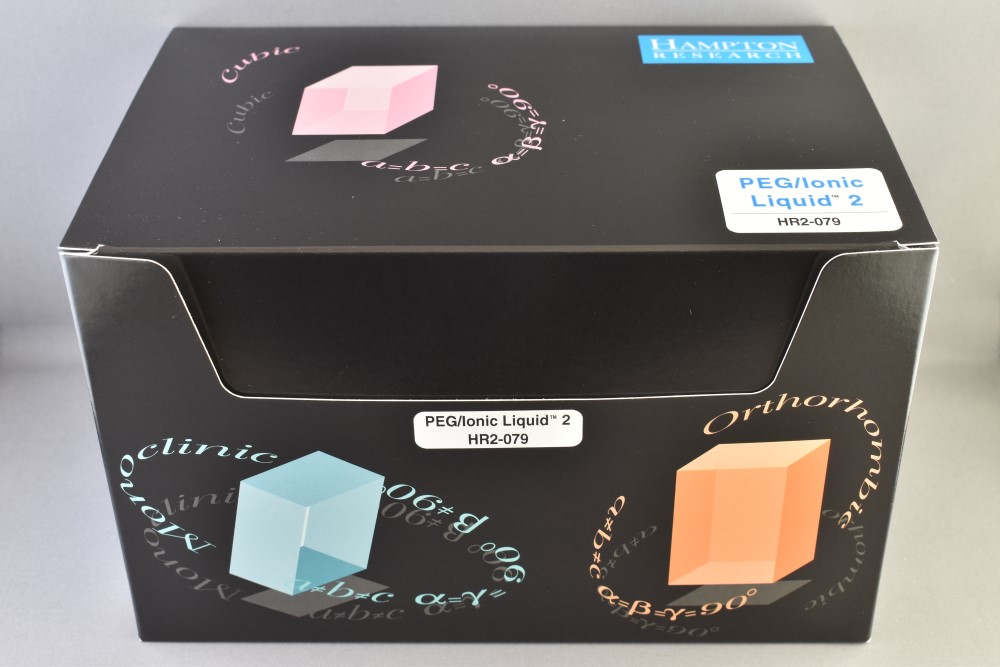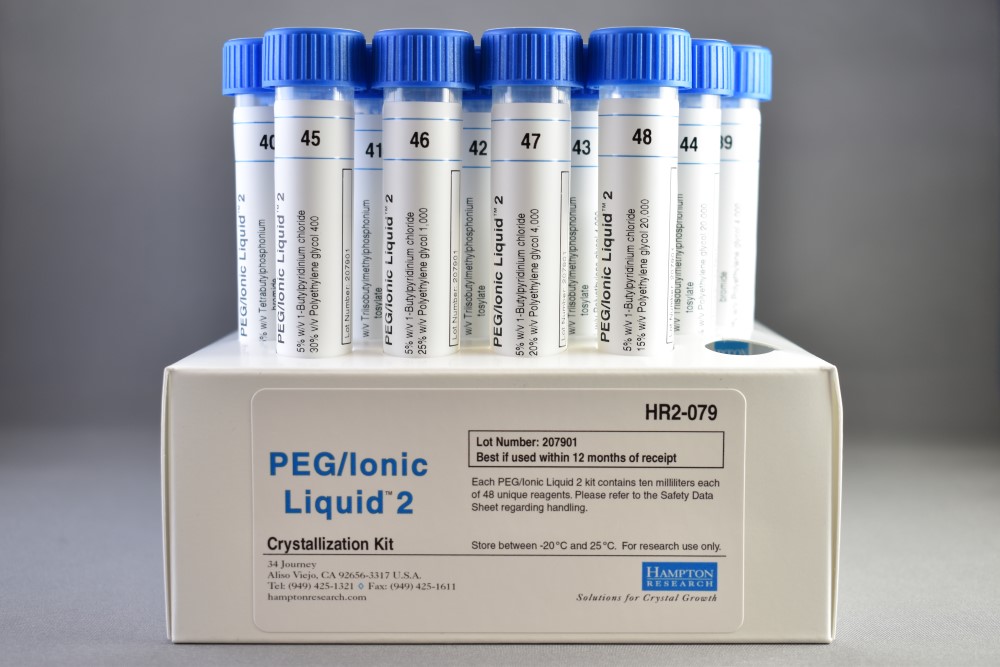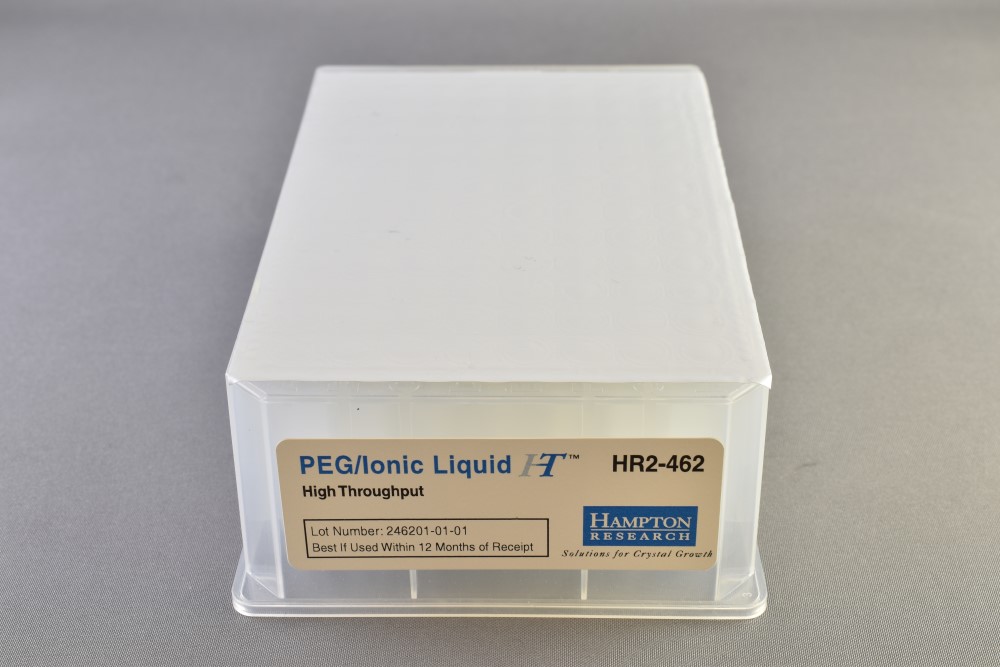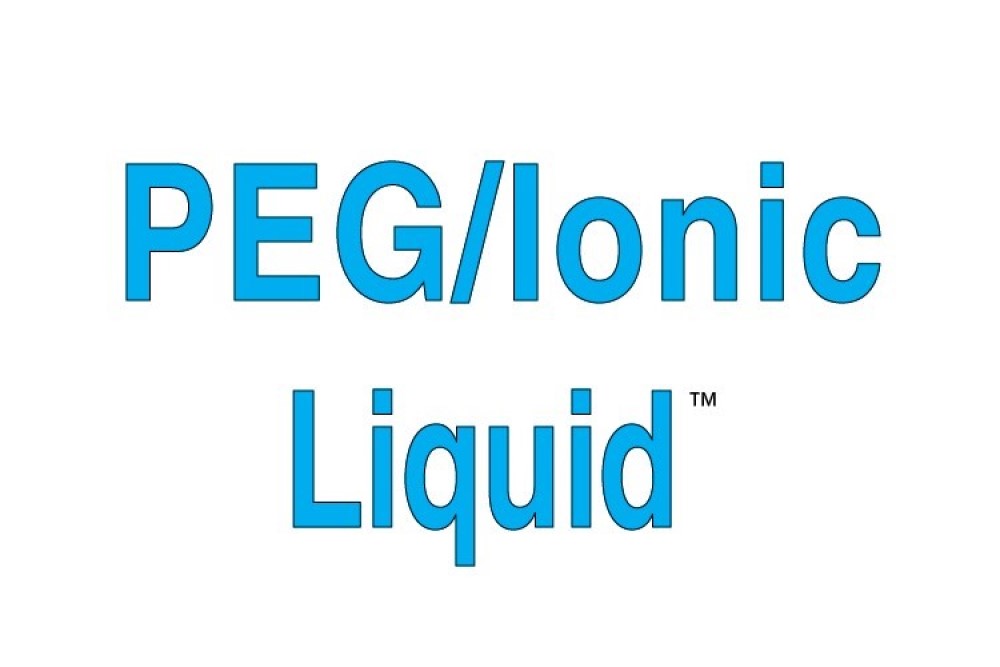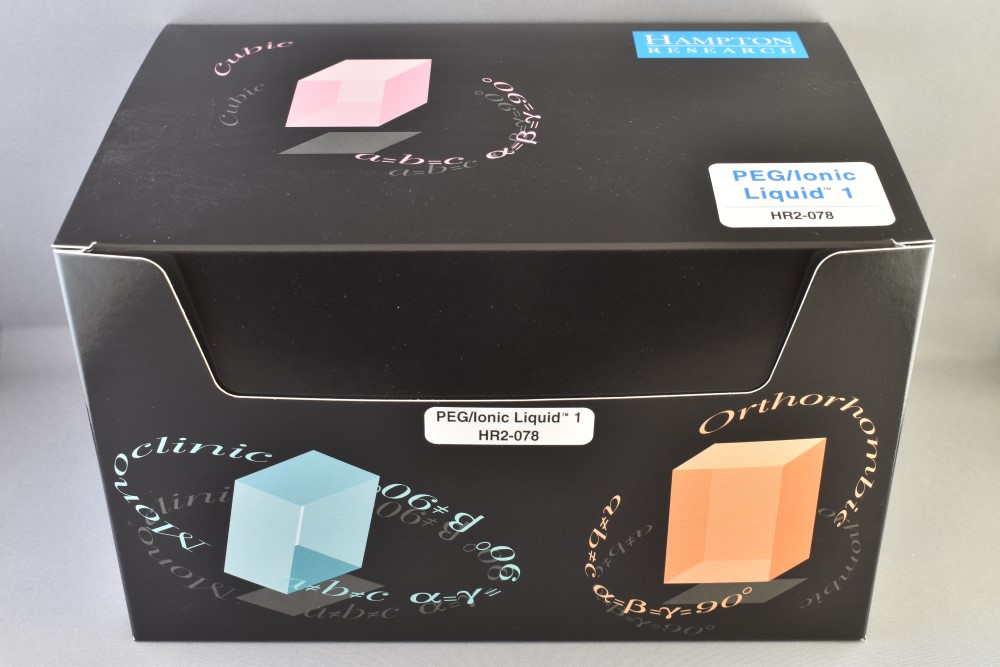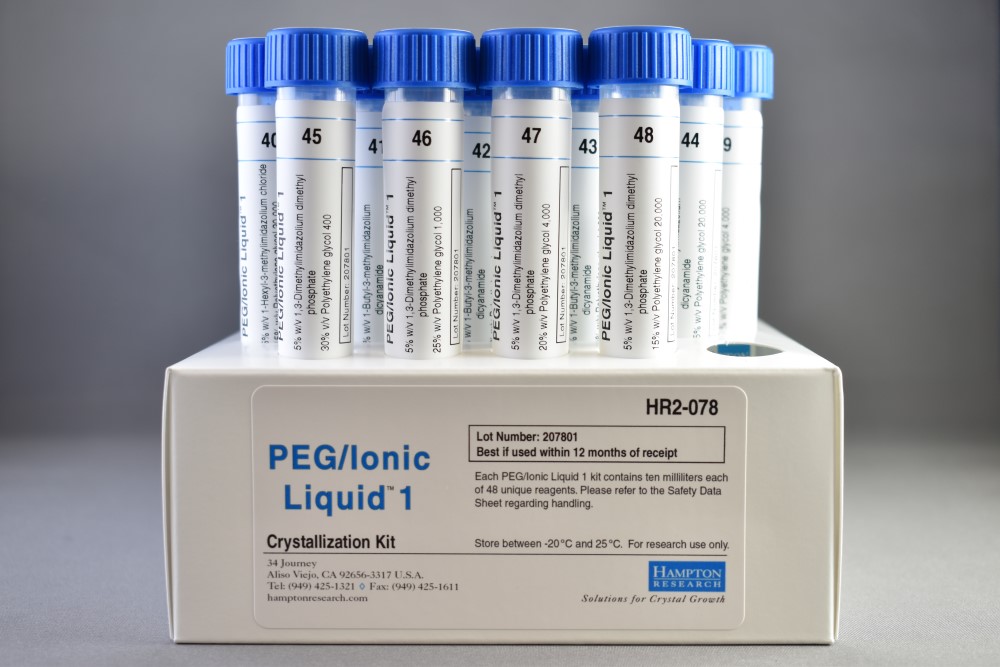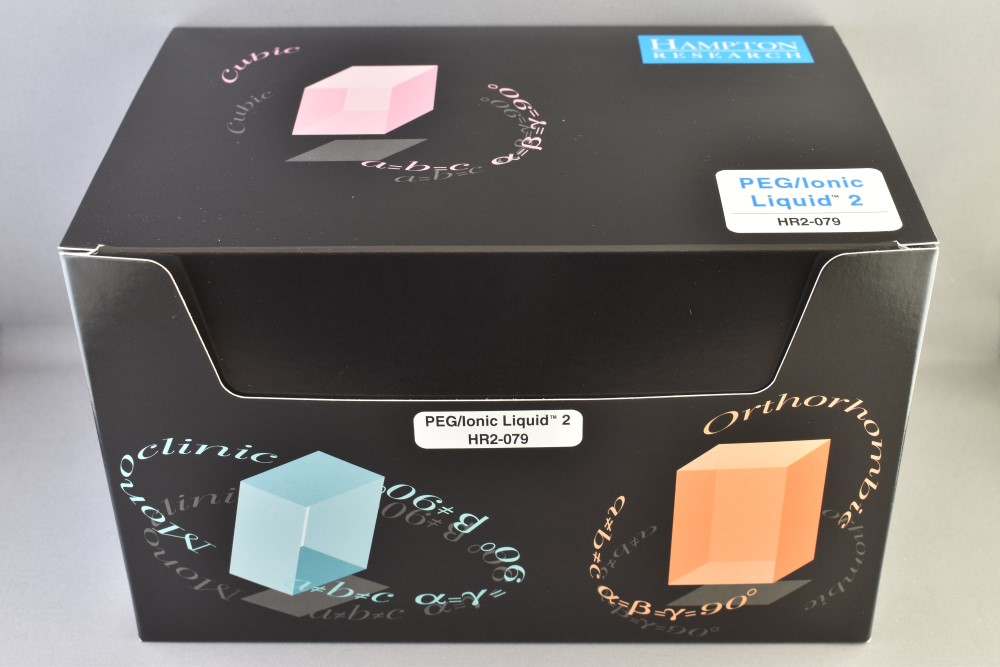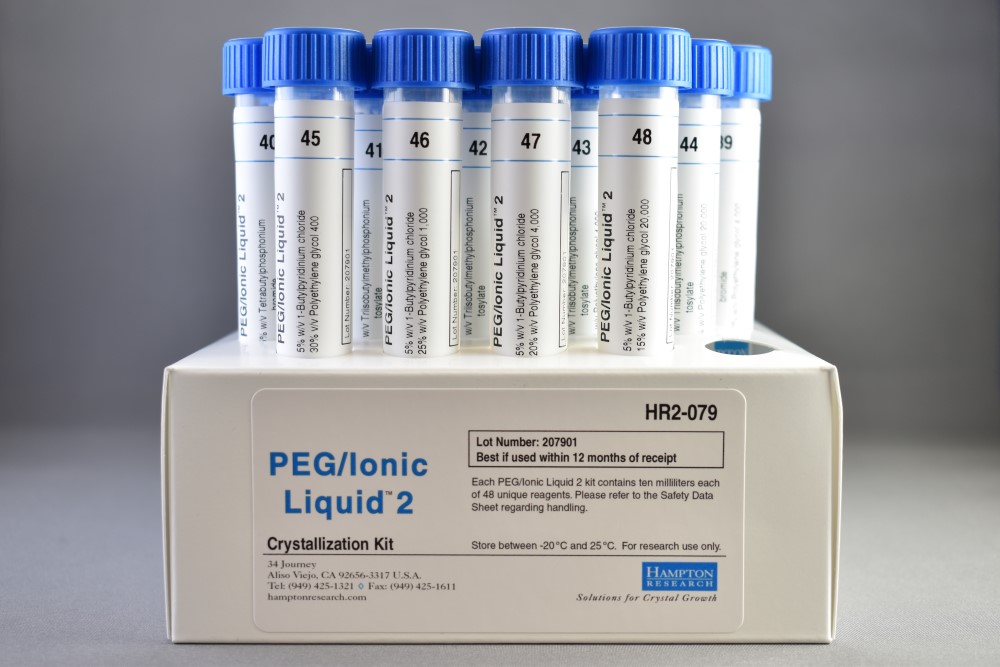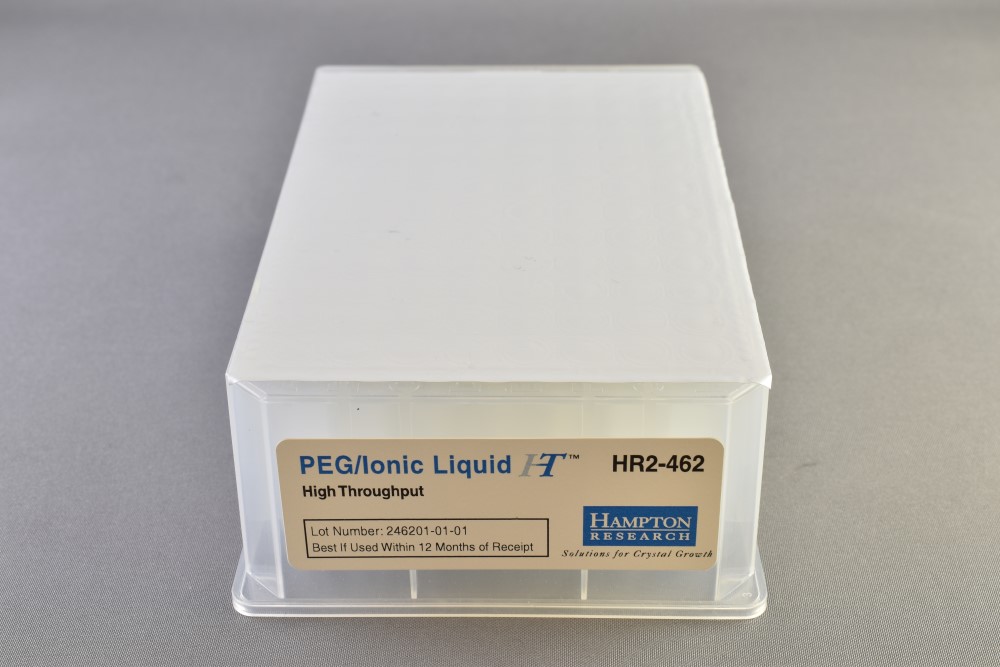Hampton Research蛋白结晶试剂盒






Products > Crystallization Screens > PEG/Ionic Liquid 1 • PEG/Ionic Liquid 2 • PEG/Ionic Liquid HT > PEG/Ionic Liquid 1 • PEG/Ionic Liquid 2
PEG/Ionic Liquid 1 • PEG/Ionic Liquid 2
Applications
Crystallization screen for biological macromolecules, where Polyethylene glycols are are the primary, and ionic liquid the secondary reagent, sampling a broad range of pH without an added buffer.
Features
- Samples a broad range of pH without an added buffer
- Polyethylene glycol 400, 1,000, 4,000, & 20,000 – primary reagent
- 24 unique ionic liquids – secondary reagent (when using both PEG/Ionic Liquid 1 & 2 or PEG/Ionic Liquid HT)
- Vapor diffusion, microbatch, free interface diffusion
Description
Ionic liquids have been found effective as additives in protein crystallization, with different ionic liquids used to increase crystallization rates and crystal size.1-4 The inclusion of ionic liquids in crystallization experiments has been reported to lead to less crystal polymorphism as well as less precipitation at higher precipitant concentrations.2,5 Ionic liquids have been used as additives to produce crystals in reagents that had previously not resulted in crystallization and results suggest ionic liquids may be applicable for the solubilization and crystallization of membrane proteins.2
Ionic liquids are organic salts with melting points below 100°Celsius. They are thermally stable, nonflammable and demonstrate very low vapor pressure. Ionic liquids are soluble in a variety of organic and inorganic reagents and can be highly water soluble. Ionic liquids can demonstrate a degree of localized structuring about each ion compared to materials composed of disassociated ions, setting them apart from salt solutions.5,6 Ionic liquids can participate in ionic, hydrophobic and hydrogen bond interactions. Ionic liquids are often chaotropic, composed of low symmetry ions with charge delocalization and weak intermolecular interactions.1 These organic salts generally consist of combinations of organic cations and either an organic or inorganic anion. Ionic liquids have been demonstrated to suppress protein aggregation and significantly increase protein folding yields.7,8 Ionic liquids have been reported to stabilize protein activity and structure.9-11 The inclusion of the ionic liquid 1-n-Butyl-3-methylimidazolium tetrafluoroborate improved the thermal stability and solubility of integral membrane proteins for membrane proteomics study.12
Some ionic liquids, such as ethylammonium nitrate have water-like characteristics, including the capacity for hydrogen bonding and the promotion of micelle formation by some surfactants.13 Many ionic liquids are also organic acids and have ionic character in addition to the hydrophobic behavior, which makes them unique and useful solvents in protein chemistry.
Variation of the anion and the cation as well as the utilization of both soft (formate and acetate) and hard anions (nitrate) in the reagents provides an additional dimension for evaluating the effects on ionic liquids on the solubility and crystallization of proteins. The screen contains 24 water soluble ionic liquids that comprise different cation (ammonium, cholin, imidazolium, phosphonium, and pyridinium) and anion (bromide, chloride, formate, nitrate, acetate, phosphate, cyanamide, sulfate, fluoroborate, fluoroacetate, sulfonate, and tosylate) structures for a diverse PEG and Ionic Liquid formulation for use in the crystallization screening of biological macromolecules.
PEG/Ionic Liquid HT samples four different low molecular weight Polyethylene glycols (400, 1,000, 4,000, and 20,000) versus twenty four ionic liquids, encompassing a broad range of pH without an added buffer. PEG/Ionic Liquid HT is supplied in a 96 Deep Well block format and is compatible with robotic and multi-channel pipet liquid handling systems. PEG/Ionic Liquid HT is compatible with vapor diffusion, free interface diffusion, and microbatch crystallization methods. For research use only.
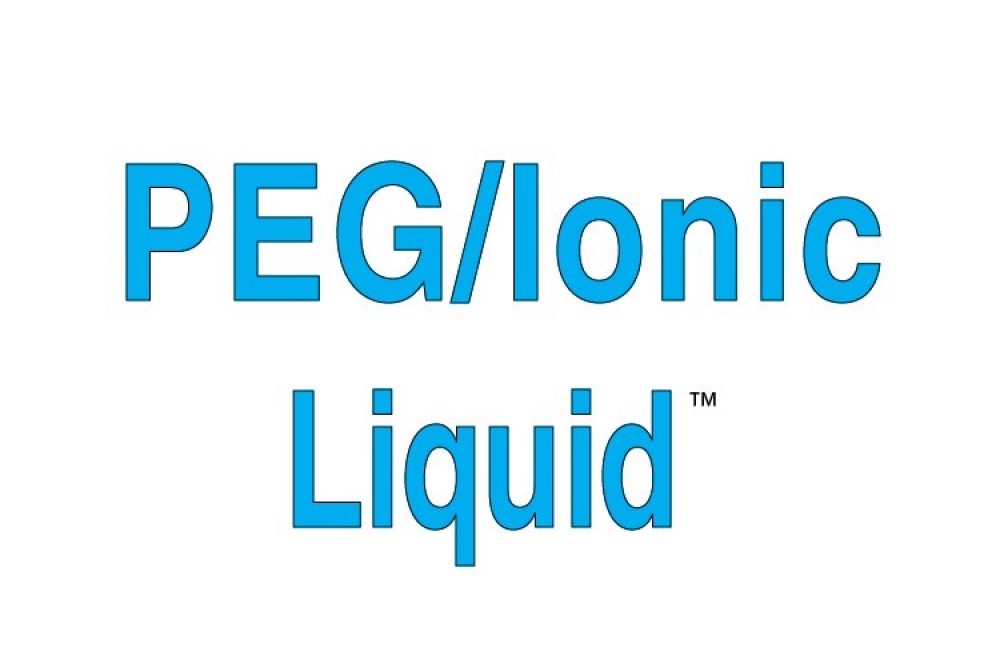
Click to Zoom In
CAT NO
HR2-078
NAME
DESCRIPTION
10 ml, tube format
PRICE
$276.00
cart quote
CAT NO
HR2-079
NAME
DESCRIPTION
10 ml, tube format
PRICE
$276.00
cart quote
CAT NO
HR2-462
NAME
DESCRIPTION
1 ml, Deep Well block format
PRICE
$161.00
cart quote
Support Material(s)
 HR2-078 PEG/Ionic Liquid 1 Documents
HR2-078 PEG/Ionic Liquid 1 Documents HR2-078 PEG/Ionic Liquid 1 SDS
HR2-078 PEG/Ionic Liquid 1 SDS HR2-079 PEG/Ionic Liquid 2 Documents
HR2-079 PEG/Ionic Liquid 2 Documents HR2-079 PEG/Ionic Liquid 2 SDS
HR2-079 PEG/Ionic Liquid 2 SDS HR2-462 PEG/Ionic Liquid HT Documents
HR2-462 PEG/Ionic Liquid HT Documents HR2-462 PEG/Ionic Liquid HT SDS
HR2-462 PEG/Ionic Liquid HT SDS PEG/Ionic Liquid Formulation & Scoring Data
PEG/Ionic Liquid Formulation & Scoring Data References
1. Introduction to protein crystallization. Alexander McPherson and Jose A. Gavira. Acta Crystallographica Section F Volume 70, Issue 1, pages 2–20, January 2014.
2. Optimization of crystallization conditions for biological macromolecules. Alexander McPherson and Bob Cudney. Acta Crystallographica Section F Volume 70, Issue 11, pages 1445–1467, November 2014.
3. Pusey, M.L., Paley, M.S., Turner, M.B., and Rogers, R.D. 2007. Protein crystallization using room temperature ionic liquids. Crystal Growth & Design. 74:787-793.
4. Hekmat, D., Hebel, D., Sebastian, J. Schmidt, M., and Weuster-Botz, D. 2007. Advanced protein crystallization using water-soluble ionic liquids as crystallization additives. Biotech. Lett., 29:703-1711.
5. Garlitz, J.A., Summers, C.A., Flowers, R.A. and Borgstahl, G.E.O. 1999. Ethylammonium nitrate: A protein crystallization reagent. Acta Cryst. D53:2037-2038.
6. Judge, R.A., Takahashi, S., Longnecker, K.L. Fry, E.H., Abad-Zapatero, C., and Chi, M.L. 2009. The effects of ionic liquids on protein crystallization and X-ray diffraction resolution. Crystal Growth & Design 9:3463-3469.
7. Bowran, D.T., Hardacre, C. Holbrey, J.D., McMath, J.E., and Soper, A.K. 2003. J. Chem. Phys. 118:173-178.
8. Cadena, C., Zhao, Q., Snurr, and R.Q., Maginn, E.J. 2006. J. Chem. Phys. B 110:2821-2832.
9. Summers, C.A. and Flowers, R.A. 2000. Protein renaturation by the liquid organic salt ethylammonium nitrate. Protein Science 9:2001-2008.
10. Lange, C., Patil, G., and Rudolph, R. 2005. Ionic liquids as refolding additives: N’-alkyl and N’-(w-hydroxyalkyl) N-methylimidazolium chloride. Protein Science 14:2693-2701.
11. Lozano, P. , de Diego, T. Guegan, J.P., Vaultier, M., and Ibora, J.L. 2001. Stabilization of a-chymotrypsin by ionic liquids in transesterification reactions. Biotehnol. Bioeng. 75:363-369.
12. Baker, S.N., McCleskey, T.M., Pandy, S., and Baker, G.A. 2004. Fluorescence study of protein thermostability in ionic liquids. Chem. Commun. 2004:940-941.
13. De Diego, T., Lozano, P., Gmouth, S. Vaultier, M., and Iborra, J.L. 2004. Fluorescence and CD spectroscopic analysis of the a-chymotrypsin stabilization by the ionic liquid 1-ethyl-3-methyimidazolium bis[(trifluormethyl)sulfonyl]amide. Biotechnol. Bioeng. 88:916-924.
14. Sun, L., Tao, D., Han, B., Ma, J., Zhu, G., Liang, Z., Shan, Y., Zhang, L., and Zhang, Y. 2010. Ionic liquid 1-butyl-3-methyl imidazolium tetrafluoroborate for shotgun membrane proteomics. Anal. Bioanal. Chem. DOI 10.1007/s0216-010-4381-5.
15. Evans, D.F., Yamauchi, A., Roman, R., and Casassa, E.Z. 1982. J. Colloids Interface Sci. 88:89-96.
16. Proteins in Ionic Liquids: Current Status of Experiments and Simulations. Christian Schröde, Top Curr Chem (J). 2017; 375(2): 25.
17. Ionic Liquids as Stabilization and Refolding Additives and Solvents for Proteins. Fujita K. Adv Biochem Eng Biotechnol. 2018 Jul 13. doi: 10.1007/10_2018_65.
18. Fujita K. (2018) Ionic Liquids as Stabilization and Refolding Additives and Solvents for Proteins. In: . Advances in Biochemical Engineering/Biotechnology. Springer, Berlin, Heidelberg.


Hampton Research, first in crystallization since 1991, developing and delivering crystallization and optimization screens, reagents, plates, and other tools for the crystallization of biological macromolecules, including proteins (antibody), peptides (insulin), and nucleic acids (DNA).
- Products
- Gallery
- My Account
|
|
|
- Contact Us
- Quick Order
- Support
|
- Privacy Policy
- Terms and Conditions
|
- Products
- Gallery
- My Account
- Support
- Contact Us
- Quick Order
- Privacy Policy
- Terms and Conditions
|
|
|
|
|
|
|
© 2022 HAMPTON RESEARCH CORP.
| Website by Skyhound Internet


